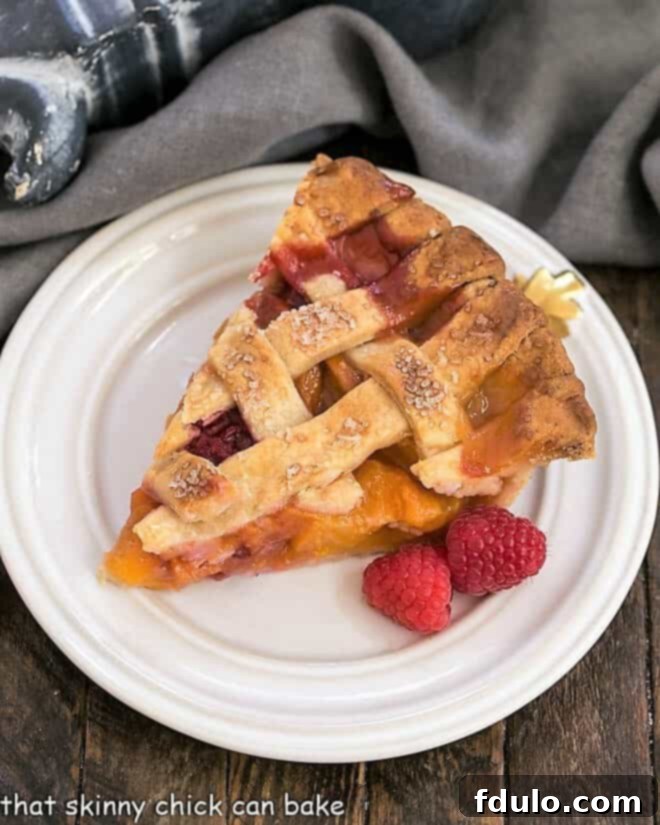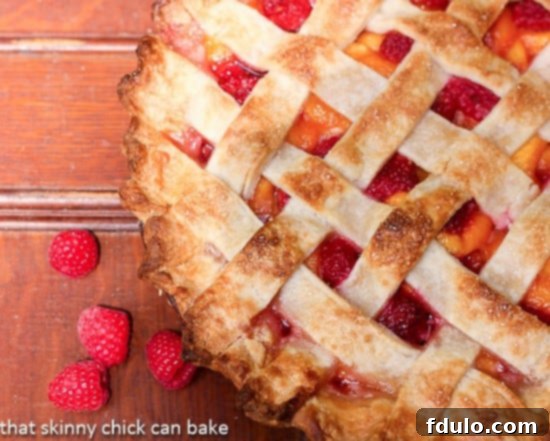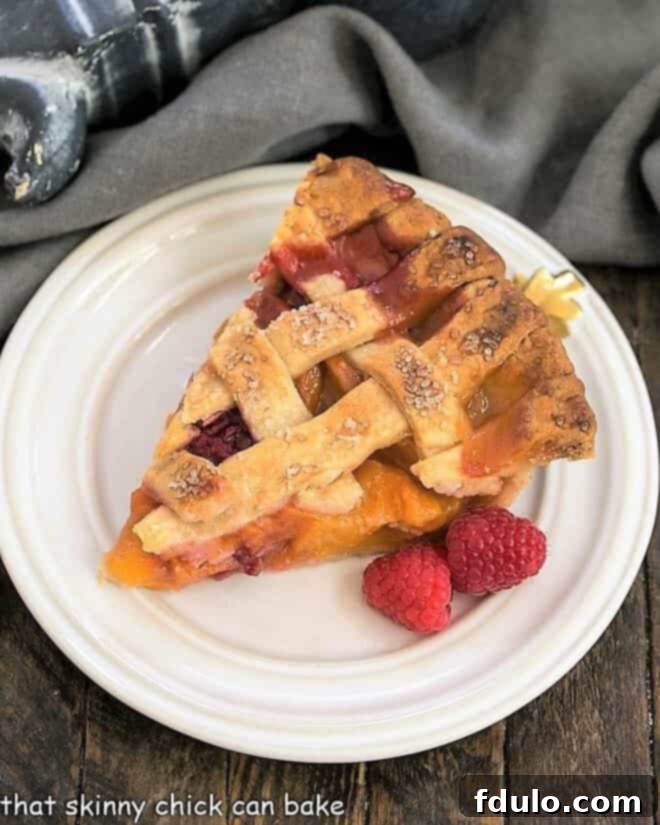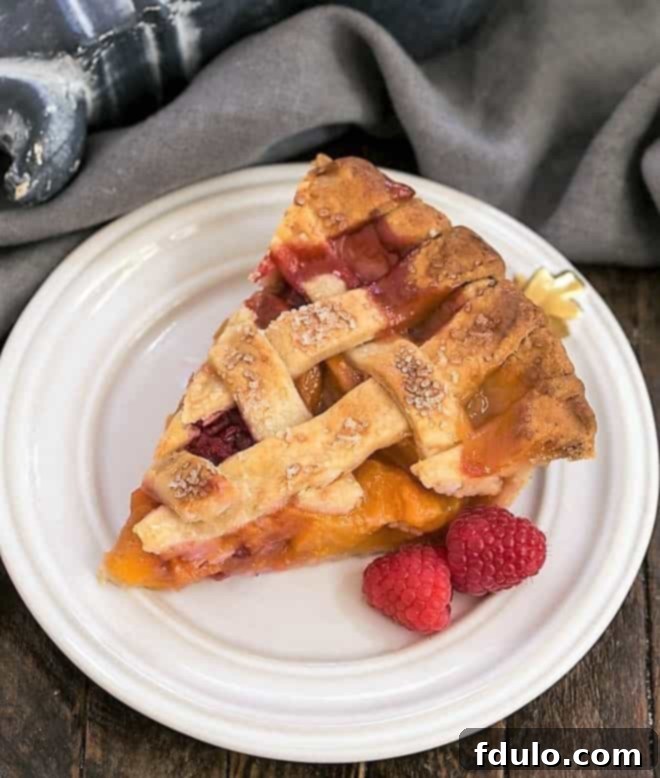This beloved Raspberry Peach Pie Recipe elevates a classic family favorite with a beautifully decorative crust. The exquisite balance of sweet, juicy fruit perfectly complemented by a handcrafted Lattice Pie Crust makes this dessert truly outstanding. This homemade pie promises simple, old-fashioned deliciousness that will evoke fond memories and easily rival the best pies from generations past.
There’s an undeniable magic in every bite of a Peach Pie with Raspberries, especially when it’s made with sweet, succulent summer peaches and ripe, slightly tart raspberries. This harmonious blend of flavors truly captures the essence of summer, delivering a tantalizing experience that celebrates peak-season produce.

Why This Raspberry Peach Pie is an Absolute Must-Make
From the very first forkful, you’ll understand why this Lattice Topped Peach Raspberry Pie quickly vanishes whenever it’s served. It’s not just delicious; it’s an experience. Several summers ago, this very pie made its debut at our annual 4th of July cookout, alongside other crowd-pleasers like a frozen grasshopper pie and a creamy sour cream corn dip, and it was the undisputed star.
- Unforgettable Flavor Combination: While this specific pie was initially a special request, its incredible taste is undeniable. The pairing of peaches and raspberries creates a ‘marriage of flavors’ reminiscent of a perfect Peach Melba Recipe, offering a beautiful blend of natural sweetness and a subtle tang that truly sings of summer.
- Seasonal Perfection: This fruit combination shines brightest in the summer months when both peaches and raspberries are at their absolute peak of freshness and flavor. Baking with seasonal ingredients ensures the most vibrant and satisfying taste.
- Elegant Presentation: Beyond its incredible taste, the decorative lattice crust adds an elegant touch, making it a showstopper for any gathering. Served warm with a generous scoop of luscious vanilla ice cream, a homemade peach pie, especially one adorned with a lattice top, becomes an unparalleled summer dessert experience.
Ingredient Notes for the Best Raspberry Peach Pie
Crafting the perfect pie begins with understanding the role of each ingredient. Here’s a detailed look at what you’ll need and why it matters for achieving that incredible flavor and texture:
- Kitchen Staples: You’ll need fundamental baking ingredients like All-Purpose Flour, Granulated Sugar, Salt, Milk, Cold Butter, and Cornstarch. These form the basic structure and flavor profile of both the crust and the filling.
- Cake Flour: Incorporating cake flour, which has a lower gluten content than regular all-purpose flour, is key to achieving a more tender and delicate pie crust. This subtle difference in flour types makes a noticeable impact on the final texture, ensuring a melt-in-your-mouth experience.
- Baking Powder: A small amount of baking powder contributes to the flakiness of the pie crust. It helps create delicate layers by releasing carbon dioxide during baking. Always check the expiration date to ensure it’s active; a quick test is to mix a spoonful in hot water—it should bubble vigorously if still good.
- Cream Cheese: Using cold cream cheese in the crust dough enriches the pastry, adding a delightful tang and tenderness. Its fat content also makes the dough more pliable and easier to handle, contributing to a smoother rolling process.
- Heavy Cream: With its high 36% butterfat content, heavy cream further enhances the richness and texture of the pie crust. It works in conjunction with the other fats to create a truly luxurious pastry.
- Cider Vinegar: Slightly sweeter and fruitier than white vinegar, cider vinegar serves a crucial purpose in the crust. The acetic acid helps to tenderize the dough by inhibiting gluten development, preventing a tough crust. Other vinegars can be used, but cider vinegar subtly complements the fruit flavors.
- Peaches: Aim for about 8 medium, or just under 3 pounds, of fresh, ripe peaches. Ripe peaches are fragrant, yielding slightly when gently squeezed. Avoid overly soft or bruised peaches, and if possible, choose freestone varieties for easier pitting.
- Raspberries: Select fresh, plump, and sweet raspberries that are free from blemishes or signs of deterioration. Taste a few before incorporating them into the pie to ensure they offer the perfect balance of sweetness and tartness.
- Fresh Lemon Juice: While bottled lemon juice can work in a pinch, fresh lemon juice is highly recommended. Its vibrant acidity not only brightens the fruit flavors but also acts as a natural antioxidant, preventing the peaches from browning.
- Turbinado or Coarse Sugar: For that extra special touch, sprinkle turbinado or coarse sugar on the glazed crust before baking. The larger crystals catch the light, adding a beautiful sparkle and a delightful textural crunch. Regular granulated sugar can be used if coarse sugar is unavailable.

Expert Tips for Crafting the Best Peach Raspberry Pie
Achieving a truly exceptional peach raspberry pie involves a few key techniques and insights. The delightful combination of sweet, juicy peaches and the vibrant, slightly tart raspberries is undeniably a winner, but ensuring peak-of-the-season fruit—whether fresh or frozen—and perfectly ripe, flavorful raspberries is paramount.
- PRO Tip: Effortless Peach Peeling. To easily peel your peaches, bring a pot of water to a rolling boil. Carefully score a small “X” on the non-stem end of each peach, just through the skin. Submerge a few peaches at a time into the boiling water for 1-2 minutes, then immediately transfer them to a bowl of ice water. This blanching method shocks the peaches, causing their skins to practically slip right off, making the peeling process incredibly simple and quick. After peeling, cut each peach in half from stem to bottom, twist to separate, remove the pit, and then slice the halves into even wedges, placing them in a bowl.
- PRO-Tip: Preventing Oxidation. As you prep your pie crust, a simple trick to keep your sliced peaches from browning or oxidizing is to sprinkle a little fresh lemon juice over them. Gently toss the peaches to ensure an even coating. This not only preserves their beautiful color but also adds a bright, zesty note that enhances the overall flavor of the filling.
- Mastering the Pie Crust: The unique crust recipe, enriched with cream cheese, is remarkably pliable and easy to work with. The addition of baking powder and cider vinegar further contributes to its incredible flakiness. These ingredients work in harmony to create a tender, buttery pastry that is forgiving to shape and manipulate, even for novice bakers. Remember to keep all crust ingredients very cold, as this prevents the butter from melting too quickly and ensures those coveted flaky layers.
- Knowing When Your Pie is Perfectly Baked: The true indicator of a properly cooked pie isn’t just a golden-brown crust. It’s crucial to bake the pie until the filling is visibly bubbling, especially near the center of the pie plate. These aren’t just gentle simmers; look for thick, slow bubbles. This vigorous bubbling confirms that the cornstarch has reached its activation temperature and has effectively thickened the peach and raspberry juices, preventing a watery filling.
- Preventing Over-Browning: If your beautiful crust edges begin to brown too quickly before the filling is thoroughly cooked and bubbling, don’t fret. Carefully cover the edges of the pie crust with strips of aluminum foil. This simple technique acts as a shield, reflecting some of the heat away from the edges and minimizing further browning, allowing the filling to finish cooking to perfection.

Photo circa 2011, 2nd year of blogging! What a journey it’s been perfecting this pie!
Frequently Asked Questions About Peach Raspberry Pie
When choosing peaches for eating fresh or baking, engage all your senses. A ripe peach should have a wonderfully sweet, fruity aroma—a true tell-tale sign of its flavor potential. Visually, examine the stem end; any green tinge usually indicates the peach was picked too early and likely won’t ripen properly or develop full flavor. Furthermore, a truly juicy and flavorful peach will feel heavy for its size, signaling a high water content. Gently give the peach a light squeeze; it should yield slightly but not be overly soft or mushy.
Determining when your pie is perfectly baked involves a few key indicators. With a lattice crust, you have the advantage of being able to directly observe the filling between the woven strips. Look for the fruit juices to be actively bubbling, and importantly, these bubbles should appear thick and slow, especially near the edges of the pan. This signifies that the fruit has cooked thoroughly and the cornstarch has properly thickened the filling. Another reliable test is to carefully insert a sharp knife into a few of the peaches. If the fruit is tender and cooked, you should feel little to no resistance. Always use the recipe’s specified baking time range as a guide, but remember that oven temperatures can vary, so your pie might require slightly more or less time. Finally, ensure the crust has achieved a beautiful golden-brown color. If the crust begins to darken too much before the filling is done, gently cover the rim with aluminum foil to prevent over-browning.
More Delightful Summer Pie Recipes:
- Easy Peach Crumb Pie
- Strawberry Cream Pie
- Grasshopper Pie
- Razzleberry Pie
- Blueberry Peach Custard Pie
- Homemade Rhubarb Pie
- Layered Ice Cream Pie
- Stars and Stripes Berry Pie
- Chocolate Ice Cream Pie
- Try an Easy Raspberry Crisp if you crave delicious fruit but want to skip the crust!
- Discover even more incredible Pie Recipes
Stay connected for more delicious recipes and baking inspiration! Find us on social media @ Instagram, Facebook, and Pinterest. Don’t forget to tag us when you try one of our recipes! And if you absolutely love the results, please consider giving it a 5-star rating in the recipe card below—your feedback is greatly appreciated!

Lattice Topped Peach Raspberry Pie
45 minutes
50 minutes
1 hour 35 minutes
8 servings
This sublime dessert features the perfect harmony of ripe red raspberries and exceptionally juicy peaches, encased in a buttery, flaky crust. A beautifully woven lattice crust elevates its presentation, making it even more special and impressive. This recipe is an adaptation from the esteemed Rosy Levy Beranbaum, ensuring a truly professional-quality result.
Ingredients
For the Flaky Pie Crust:
- 12 tablespoons (1½ sticks) very cold unsalted butter, cut into ¾-inch cubes
- 1½ cups all-purpose flour
- ¾ cup cake flour
- ¼ teaspoon fine sea salt
- ¼ teaspoon baking powder
- ½ cup plus 1 tablespoon (approximately 125g) very cold cream cheese, cut into small pieces
- 3 tablespoons cold heavy cream (36% butterfat)
- 1 tablespoon cold cider vinegar
For the Juicy Fruit Filling:
- 2¾ pounds ripe peaches (about 8 medium-sized peaches)
- 1 cup fresh raspberries
- 1 tablespoon fresh lemon juice (bottled not recommended for best flavor)
- ⅔ cup granulated sugar
- Pinch of salt
- 4 teaspoons cornstarch
For the Golden Glaze:
- 2 tablespoons milk
- 1 tablespoon turbinado sugar or coarse granulated sugar (for sparkle)
Instructions
- Prepare the Butter: To begin making the pie crust, ensure your butter is extremely cold. Cut the 12 tablespoons of cold butter into precise ¾-inch cubes. Keep them in the refrigerator until ready to use.
- Combine Dry Ingredients: In the bowl of a food processor, combine the all-purpose flour, cake flour, salt, and baking powder. Pulse for a few seconds until these dry ingredients are thoroughly combined.
- Add Cream Cheese: Cut the very cold cream cheese into three or four pieces and add it to the flour mixture in the food processor. Process for about 20 seconds, or until the mixture takes on a fine, cornmeal-like consistency.
- Incorporate Butter: Now, add the cold butter cubes to the food processor. Pulse in short, 3-second bursts, about five times, until no butter pieces are larger than a small pea. It’s important to keep the butter distinct for a flaky crust.
- Add Liquids: Pour in the heavy cream and cider vinegar. Pulse the mixture in short bursts until the dough just begins to come together. The dough will still appear somewhat crumbly, but when you press a small amount between your fingers, it should coalesce into a smooth mass.
- Form the Dough: Turn the dough out onto a clean, lightly floured work surface. Gently gather and press the dough together with your hands to form a cohesive mass. Avoid overworking the dough to maintain its tenderness.
- Divide and Shape: Cut the dough in half. Shape one half into a flat, round disk, which will be for the bottom crust. Shape the other half into a flat, rectangular shape for the lattice top.
- Chill the Dough: Wrap each shaped dough piece tightly in plastic wrap. Refrigerate them for at least 45 minutes to allow the gluten to relax and the butter to firm up, making the dough easier to roll.
- Roll the Bottom Crust: Remove the disk of dough from the refrigerator (keep the rectangular dough chilled). If it’s very firm, let it sit at room temperature for 10 to 15 minutes until it is pliable enough to roll without cracking. On a lightly floured surface, roll the dough out to a 13-inch round with an approximate ⅛-inch thickness.
- Fit into Pie Pan: Carefully transfer the rolled dough into a standard 9-inch pie pan. Gently fit the dough into the contours of the pan, pressing it firmly against the bottom and sides. Trim any excess dough, leaving about a ¾-inch overhang.
- Create the Edge: Fold the ¾-inch overhang underneath itself to create a neat, thick edge around the rim of the pie pan. Cover the dough-lined pie plate with plastic wrap and refrigerate it while you prepare the filling.
- Prepare the Peaches: Using the blanching method described in the tips (or your preferred method), peel the peaches. Halve each peach, remove the pit, and then slice each half into eight thin wedges. You should yield approximately 6 cups of sliced peaches.
- Season the Peaches: Place the sliced peaches in a large bowl. Sprinkle the fresh lemon juice over them to prevent browning and enhance flavor. Add the granulated sugar and a pinch of salt, then toss gently to ensure everything is evenly coated.
- Macerate and Collect Juices: Let the peaches sit at room temperature for at least 30 minutes, or up to 12 hours (refrigerated if longer than 1 hour). This allows the sugar to draw out the natural juices. Transfer the peaches to a colander placed over a bowl to collect all the delicious juices. You should have nearly 1 cup of liquid.
- Reduce Peach Juices: Pour the collected peach juices into a small saucepan and place it over medium heat. Bring the liquid to a simmer and boil it down, swirling occasionally but avoiding constant stirring, until it becomes syrupy and reduces to about ½ cup. This concentrating step intensifies the flavor. Remove from heat and let it cool for 1 or 2 minutes.
- Thicken the Filling: Transfer the macerated peaches back to a clean bowl. Sprinkle the cornstarch over them and toss gently until all traces of the cornstarch have disappeared, coating the peaches evenly. Pour the slightly cooled, reduced peach syrup over the peaches, tossing gently one last time.
- Prepare Lattice Dough: Remove the rectangular dough from the refrigerator. Allow it to sit at room temperature for 10 to 15 minutes, or until it’s pliable enough to roll without resistance.
- Roll Lattice Strips: On a lightly floured surface, roll the rectangular dough into an 11×14-inch (or slightly larger) rectangle. It should be no more than ⅛ inch thick.
- Cut Lattice Strips: Using a ruler and a sharp knife (or a fluted pastry wheel for decorative edges), cut ten ¾-inch-wide strips lengthwise down the rectangle. Mark ¾-inch intervals for precision.
- Assemble the Pie: Give the peach filling a final stir, then carefully fold in the fresh raspberries. Pour the fruit mixture into the chilled pie shell, spreading it evenly. Arrange five of the dough strips evenly over the filling, starting with a long strip directly down the center.
- Begin Weaving (First Side): Gently fold back every other strip (the second and the fourth strips) so they lie a little past the center. Select another long dough strip, hold it perpendicular to the existing strips, and carefully lay it across the center of the pie. Unfold the two folded strips back over the perpendicular strip so they lie flat.
- Continue Weaving (Second Side): Now, fold back the strips that were not folded last time (the first, third, and fifth ones). Lay a second perpendicular strip of dough about ¾-inch away from the first perpendicular strip. Unfold the three folded strips over it. Then, fold back the original two alternating strips, set a third perpendicular strip of dough ¾-inch from the last one, and unfold the two strips.
- Complete Weaving: Repeat this weaving pattern on the other side of the pie with the two remaining strips. Always remember to alternate which strips are folded back to create a classic woven lattice effect. Once the lattice is complete, trim any excess dough from the strips flush with the bottom crust’s edge. Flute or crimp the edges of the pie as desired for a beautiful finish.
- Chill Again: Lightly cover the assembled pie with plastic wrap and refrigerate for at least 1 hour. This helps the crust retain its shape and flakiness during baking. Preheat your oven to 425°F (220°C).
- Apply Glaze: Once the pie has thoroughly chilled, gently brush the lattice top with milk. Then, generously sprinkle the turbinado or coarse sugar over the milk-brushed crust for a sparkling, crunchy finish.
- Bake the Pie: Place the pie directly onto a foil-lined baking sheet (to catch any potential drips) and transfer it to the preheated oven. Bake until the fruit juices are bubbling vigorously and thickly all over (especially near the pan edges), which typically takes 40 to 50 minutes.
- Prevent Over-Browning: After the initial 15 minutes of baking, carefully cover the outer rim of the crust with strips of aluminum foil to prevent it from over-browning while the filling continues to cook.
- Cool Completely: Once baked, transfer the pie to a wire rack and let it cool completely until the juices have fully thickened and set. This crucial cooling period can take at least 3 hours. Resist the temptation to slice it too early, as the filling needs time to firm up.
Notes
Prep time does not include the essential chilling time for the pie dough, which is critical for a flaky crust. Plan accordingly to allow for at least 45 minutes of chilling for the dough disks and another hour for the assembled pie.
Recommended Products for Perfect Pie Baking
As an Amazon Associate and member of other affiliate programs, I earn from qualifying purchases, helping to support this blog.
- Roul’Pat silicone counter sized silicone mat
- French Rolling Pin
- Food Processor
Nutrition Information:
Yield:
8
Serving Size:
1 slice
Amount Per Serving:
Calories: 486Total Fat: 21gSaturated Fat: 13gTrans Fat: 1gUnsaturated Fat: 7gCholesterol: 54mgSodium: 245mgCarbohydrates: 72gFiber: 5gSugar: 39gProtein: 6g
HOW MUCH DID YOU LOVE THIS RECIPE?
Please leave a comment on the blog or share a photo on Pinterest

A cherished memory from the 4th of July, 2011, when this very pie recipe first made its debut and became an instant classic.
